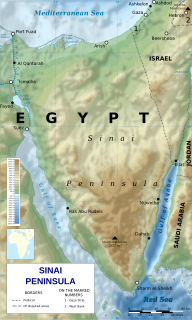
The Sinai Peninsula, or simply Sinai, is a peninsula in Egypt, and the only part of the country located in Asia. It is between the Mediterranean Sea to the north and the Red Sea to the south, and is a land bridge between Asia and Africa. Sinai has a land area of about 60,000 km2 (23,000 sq mi) and a population of approximately 600,000 people. Administratively, the vast majority of the area of the Sinai Peninsula is divided into two governorates: the South Sinai Governorate and the North Sinai Governorate. Three other governorates span the Suez Canal, crossing into African Egypt: Suez Governorate on the southern end of the Suez Canal, Ismailia Governorate in the center, and Port Said Governorate in the north.

The United Nations Truce Supervision Organization (UNTSO) is an organization founded on 29 May 1948 for peacekeeping in the Middle East. Established amidst the 1948 Arab–Israeli War, its primary task was initially to provide the military command structure to the peacekeeping forces in the Middle East to enable the peacekeepers to observe and maintain the ceasefire, and in assisting the parties to the Armistice Agreements in the supervision of the application and observance of the terms of those Agreements. The organization's structure and role has evolved over time as a result of the various conflicts in the region and at times UNTSO personnel have been used to rapidly deploy to other areas of the Middle East in support of other United Nations operations. The command structure of the UNTSO was maintained to cover the later peacekeeping organisations of the United Nations Disengagement Observer Force (UNDOF) and the United Nations Interim Force in Lebanon (UNIFIL) to which UNTSO continues to provide military observers.
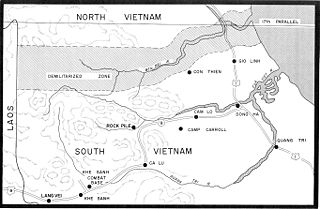
A demilitarized zone is an area in which treaties or agreements between nations, military powers or contending groups forbid military installations, activities or personnel. A DMZ often lies along an established frontier or boundary between two or more military powers or alliances. A DMZ may sometimes form a de facto international border, such as the Korean Demilitarized Zone. Other examples of demilitarized zones are a 190-kilometre-wide (120 mi) area between Iraq and Kuwait, Antarctica and outer space.

The Camp David Accords were a pair of political agreements signed by Egyptian President Anwar Sadat and Israeli Prime Minister Menachem Begin on 17 September 1978, following twelve days of secret negotiations at Camp David, the country retreat of the President of the United States in Maryland. The two framework agreements were signed at the White House and were witnessed by President Jimmy Carter. The second of these frameworks led directly to the 1979 Egypt–Israel peace treaty. Due to the agreement, Sadat and Begin received the shared 1978 Nobel Peace Prize. The first framework, which dealt with the Palestinian territories, was written without participation of the Palestinians and was condemned by the United Nations.
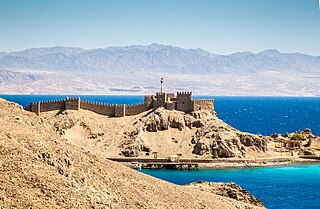
Taba is an Egyptian town near the northern tip of the Gulf of Aqaba. Taba is the location of Egypt's busiest border crossing with neighboring Eilat, Israel. Taba was originally developed as a tourist destination by the Israelis with the first hotel opening there in the 1960s, and today it is a frequent vacation spot for Egyptians and other tourists, especially those from Israel on their way to other destinations in Egypt or as a weekend getaway. It is the northernmost resort of Egypt's Red Sea Riviera.

The Egypt–Israel peace treaty was signed in Washington, D.C., United States on 26 March 1979, following the 1978 Camp David Accords. The Egypt–Israel treaty was signed by Egyptian president Anwar Sadat and Israeli prime minister Menachem Begin, and witnessed by United States president Jimmy Carter.

Yamit was an Israeli settlement in the northern part of the Sinai Peninsula with a population of about 2,500 people. Yamit was established during Israel's occupation of the peninsula from the end of the 1967 Six-Day War until that part of the Sinai was handed over to Egypt in April 1982, as part of the terms of the 1979 Egypt–Israel Peace Treaty. Prior to the return of the land to Egypt, all the homes were evacuated and bulldozed.
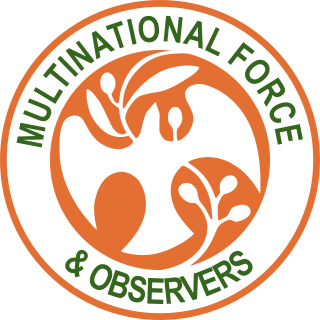
The Multinational Force and Observers (MFO) is an international peacekeeping force overseeing the terms of the peace treaty between Egypt and Israel. The MFO generally operates in and around the Sinai peninsula.

The first United Nations Emergency Force (UNEF) was established by United Nations General Assembly to secure an end to the Suez Crisis with resolution 1001 (ES-I) on 7 November 1956. The force was developed in large measure as a result of efforts by UN Secretary-General Dag Hammarskjöld and a proposal and effort from Canadian Minister of External Affairs Lester B. Pearson, who would later win the Nobel Peace Prize for it. The General Assembly had approved a plan submitted by the Secretary-General which envisaged the deployment of UNEF on both sides of the armistice line; Egypt accepted receiving the UN forces, but Israel refused it. The first UNEF lasted until 1967. The Second United Nations Emergency Force deployed from October 1973 to July 1979.
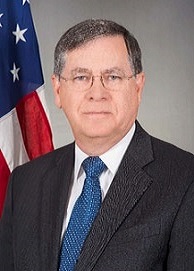
David Michael Satterfield is an American diplomat and U.S. Ambassador, who has served extensively in the Middle East, including the Persian Gulf area, Lebanon, and Iraq. He later served as a Senior Advisor on Iraq for Secretary of State Condoleezza Rice and was Director General of the Multinational Force and Observers, the peacekeeping force for the Sinai Peninsula from June 2009 until August 2017. He was chargé d'affaires to Egypt from August 2013 to January 2014 and was subsequently Special Advisor to the Secretary of State for Libya. From September 2017 to June 2019 he served as the Acting Assistant Secretary of State for Near Eastern Affairs, and was confirmed as US ambassador to Turkey on June 27, 2019.

The Israeli-occupied territories refers to the territories occupied by Israel during the Six-Day War of 1967. It also sometimes refers to areas of Southern Lebanon where Israeli military was present to support local Lebanese militias during the civil war and after it. Originally, the sole governance of the territories were as the Jordanian-annexed West Bank, the Egyptian-occupied Gaza Strip, the Egyptian Sinai Peninsula, and the Syrian Golan Heights. The first use of the term 'territories occupied' was in United Nations Security Council Resolution 242 following the Six-Day War in 1967, which called for "the establishment of a just and lasting peace in the Middle East" to be achieved by "the application of both the following principles: ... Withdrawal of Israeli armed forces from territories occupied in the recent conflict ... Termination of all claims or states of belligerency" and respect for the right of every state in the area to live in peace within secure and recognized boundaries. In addition to the territories occupied following the Six-Day War, Israel also occupied portions of Southern Lebanon following the 1982 Lebanon War, and maintained a military presence there until withdrawing in 2000.

The Jarring Mission refers to efforts undertaken by Gunnar Jarring to achieve a peaceful settlement of the conflict between Israel and its Arab neighbors after the Six-Day War in 1967. He was appointed on 23 November 1967 by UN Secretary-General, U Thant, as Special Envoy under the terms of UN Security Council Resolution 242 to negotiate the implementation of the resolution.
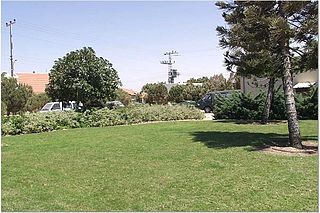
Bnei Atzmon was an Israeli settlement previously in the Sinai Peninsula, later moved to the Gaza Strip before being destroyed in 2005.

Operation Eagle was an Egyptian military campaign in the Sinai Peninsula, that was launched in August 2011 to confront the Sinai insurgency. The campaign was aimed against Islamist insurgents, who had been attacking the Egyptian security forces in the Sinai and using the area as a base from which to attack Israel since early 2011. Successive Egyptian operation against insurgents in 2012, named Operation Sinai, was initially referred as the second part of Operation Eagle. It was the first in a number of campaigns to retake the Sinai from insurgents that lasts to this day.
Operation Mazurka is the Australian Defence Force's (ADF) contribution to the Multinational Force and Observers (MFO), an international peacekeeping force, based in the Sinai Peninsula, overseeing the terms of the Israel-Egypt Peace Treaty.
Civilian employees working for the Multinational Force and Observers mission in the Sinai are authorized the MFO Civilian Medal in recognition of their service in the cause of peace.
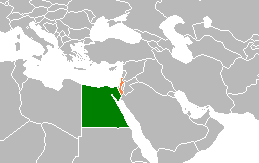
Egypt–Israel relations are foreign relations between Egypt and Israel. The state of war between both countries which dated back to the 1948 Arab–Israeli War culminated in the Yom Kippur War in 1973, and was followed by the 1979 Egypt–Israel Peace Treaty a year after the Camp David Accords, mediated by U.S. president Jimmy Carter. Full diplomatic relations were established on January 26, 1980, and the formal exchange of ambassadors took place one month later, on February 26, 1980, with Eliyahu Ben-Elissar serving as the first Israeli Ambassador to Egypt, and Saad Mortada as the first Egyptian Ambassador to Israel. Egypt has an embassy in Tel Aviv and a consulate in Eilat. Israel has an embassy in Cairo and a consulate in Alexandria. Their shared border has two official crossings, one at Taba and one at Nitzana. The crossing at Nitzana is for commercial and tourist traffic only. The two countries' borders also meet at the shoreline of the Gulf of Aqaba in the Red Sea.

Australian military involvement in peacekeeping operations has been diverse, and included participation in both United Nations sponsored missions, as well as those as part of ad hoc coalitions. Indeed, Australians have been involved in more conflicts as peacekeepers than as belligerents; however, according to Peter Londey "in comparative international terms, Australia has only been a moderately energetic peacekeeper." Although Australia has had peacekeepers in the field continuously for 60 years – the first occasion being in Indonesia in 1947, when Australians were among the first group of UN military observers – its commitments have generally been limited, consisting of small numbers of high-level and technical support troops or observers and police. David Horner has noted that the pattern changed with the deployment of 600 engineers to Namibia in 1989–90 as the Australian contribution to UNTAG. From the mid-1990s, Australia has been involved in a series of high-profile operations, deploying significantly large units of combat troops in support of a number of missions including those in Cambodia, Rwanda, Somalia and later in East Timor. Australia has been involved in close to 100 separate missions, involving more than 30,000 personnel and 10 Australians have died during these operations.
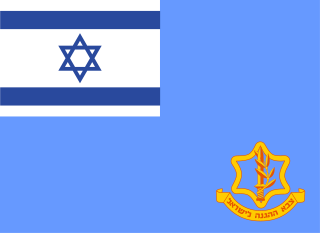
The Israeli Military Governorate was a military governance system established following the Six-Day War in June 1967, in order to govern the civilian population of the West Bank, the Gaza Strip, the Sinai Peninsula and the Western part of Golan Heights. The governance was based on the Fourth Geneva Convention, which provides guidelines for military rule in occupied areas. East Jerusalem was the only exception from this order, and it was added to Jerusalem municipal area as early as 1967, and extending Israeli law to the area effectively annexing it in 1980. During this period, the UN and many sources referred to the military governed areas as Occupied Arab Territories.
The Israeli occupation of the Sinai Peninsula was a 15-year-long military occupation of the Sinai Peninsula by Israeli forces that occurred after Israel's seizure of the region from Egypt during the 1967 Arab–Israeli War. Israeli provisional control over the Sinai Peninsula ended in 1982 following the implementation of the 1979 Egypt–Israel peace treaty, which saw Israel return the region to Egypt in exchange for the latter's recognition of Israel as a legitimate sovereign state.
















